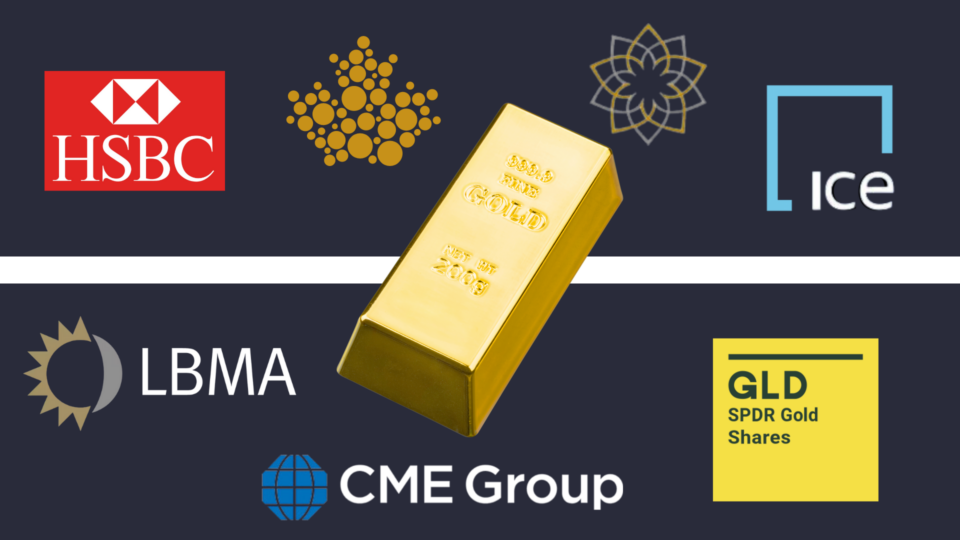The “gold spot price” refers to the price an investor will pay for the immediate delivery of one ounce of gold. But who decides it?
What is the gold spot price?
Click here to view the live spot price of gold. It represents the price an investor will pay right now for one ounce of gold (not including commissions or premiums).
Who determines the gold spot price?
When someone says “the gold spot price,” it gives the impression that there is a single, centralized spot price of gold. But this is not the case.
The “spot price” is a theoretical estimate of the real-time market value of gold. It is not published by any government or official entity. Rather, individual exchanges and brokerage firms find the closest approximation using different benchmarks, such as:
- The NYMEX Continuous Contract Price
- The LBMA Gold Price
- Gold ETF Prices
- Prices from gold wholesalers
The NYMEX Continuous Contract Price
The New York Mercantile Exchange (NYMEX), a part of the CME Group, is the world’s largest commodities futures exchange.
A “futures contract” is an agreement to buy or sell a specific quantity of gold in the future for a specific price. Futures contracts allow companies or investors to lock in a price today for a product that will be delivered tomorrow.
Because each contract expires on a specific date, it is difficult to provide a continuous, long-term price of gold without the gaps and interruptions caused by contract expirations.
The “continuous contract price” solves this problem by linking the prices of successive futures contracts to create a single, uninterrupted price chart. The composite price provides an accurate real-time benchmark for the price of gold.
The LBMA Gold Price
The London Bullion Market Association (LBMA) is an international trade association that represents the global over-the-counter (OTC) market for gold and silver bullion.
The LBMA Gold Price (or Daily Auction Gold Price) is a global benchmark for gold. It is determined through an electronic auction process run by ICE Benchmark Administration.
The auction is conducted twice every day (at 10:30am and 3:00pm London time). During the auction, banks, bullion dealers, refiners, institutional investors, and other market participants submit buy and sell orders for gold. The system calculates a clearing price that matches the highest number of buy and sell orders.
The bids, offers, and final prices in the auction are calculated and displayed in US Dollars, regardless of the participants’ locations or the currencies they might typically use. This standardizes the pricing and makes it easier for all participants to understand and compare bids.
Gold ETF Prices
Large gold-backed exchange-traded funds also serve as accurate benchmarks for the market price of gold. The largest such ETF is SPDR Gold Shares, also known as GLD.
Gold ETFs allow investors to gain exposure to gold without holding the physical metal. When investors buy shares in a gold-backed ETF, the fund must purchase physical gold to back those shares. When investors sell shares, the fund sells physical gold.
Large inflows or outflows from gold ETFs can lead to significant price movements, as the funds’ activities can represent a substantial portion of daily trading volumes in the gold market.
Prices from gold wholesalers
Gold refiners and wholesalers often quote their own spot price, which can be used as a benchmark. The world’s largest gold wholesalers include Metalor, PAMP, and Argor-Heraeus in Switzerland, Asahi and Elemetal in the US, and the Royal Canadian Mint in Canada.
What drives the gold spot price?
Traders often exploit price discrepancies between futures, spot, and wholesale markets, which helps align prices across these different exchanges. For example, if the spot price is significantly lower than the futures price, traders might buy spot gold and sell futures, driving the prices toward equilibrium.
For a more detailed look at the factors that drive gold, check out this article: What makes the gold price rise and fall?
Vaulted: buy gold with the tap of a finger
Vaulted is the simplest way to own physical gold. It takes 30 seconds to set up your free Vaulted account, where you can buy real gold and silver in any quantity.
You have direct ownership of segregated, serial-numbered bars. Plus, you can take delivery of your metals at any time.











